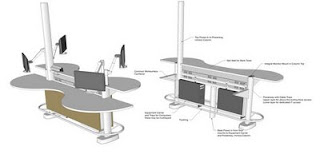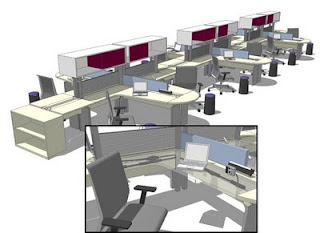Steelcase Furniture saves time with SketchUp
April 28th, 2009 | Published in Google SketchUp
Our latest case study, Steelcase Office Furniture, demonstrates a unique use of Google SketchUp Pro. Known for its excellence in design and attention to detail during the design process, Steelcase shares how they use SketchUp for everything from initial design problem-solving to developing final product specifications in a workflow that encompasses both industrial design and interior architecture. Below is just a part of the case study - visit the case study online to read the story in its entirety (and see more images).
Steelcase Office Furniture began in 1912 as The Metal Office Furniture Company in Grand Rapids, Michigan. The company received its first patent in 1914 for a steel wastebasket -- a major innovation at a time when straw wastebaskets were a major office fire hazard. Today, Steelcase has some 13,000 employees and more than 600 dealer locations around the world, and offers solutions addressing the three core elements of office environments: interior architecture, furniture and technology.
In 2004, Steelcase began using Google SketchUp. SketchUp made it simple to render basic models using desktop computers. Suddenly, Steelcase designers were able to create models of preliminary design concepts much earlier in the design process, without having to power up a supercomputer. According to Karl Mead, Principal Designer at Nurture, a Steelcase company focused on developing workplace design solutions for healthcare companies, “SketchUp let us see what products would look like, or model complete worlds full of many products, using our existing Macs and Windows machines.”
 Today, Steelcase designers use SketchUp to develop and share design ideas at all steps of the product development process – from R&D, to concepting and prototyping product ideas, to developing final product specifications. According to Mead, “We can start solving problems very early in the product development process and get to better solutions faster.” And because SketchUp’s simple enough that non-engineers can use it, it makes it easy for designers to solicit and integrate feedback from customers and sales and marketing folks. According to Robin Bowles, Principal Designer, Workspace Futures, “People download SketchUp, and with little training, validate products before we go into hard engineering.”
Today, Steelcase designers use SketchUp to develop and share design ideas at all steps of the product development process – from R&D, to concepting and prototyping product ideas, to developing final product specifications. According to Mead, “We can start solving problems very early in the product development process and get to better solutions faster.” And because SketchUp’s simple enough that non-engineers can use it, it makes it easy for designers to solicit and integrate feedback from customers and sales and marketing folks. According to Robin Bowles, Principal Designer, Workspace Futures, “People download SketchUp, and with little training, validate products before we go into hard engineering.”
SketchUp has also become central to Steelcase’s sales and marketing efforts. Salespeople access an extensive library of images of the company’s products, which Steelcase stores in Google 3D Warehouse, to show customers specific product features, or to create custom models of complex solutions in a matter of seconds. Marketing people also use the company’s image library, to create marketing materials.

With Google SketchUp and the Google 3D Warehouse, Steelcase develops and markets new products more quickly and cost-effectively than ever. As Mead puts it, “SketchUp is a critical factor in our success.”
Steelcase Office Furniture began in 1912 as The Metal Office Furniture Company in Grand Rapids, Michigan. The company received its first patent in 1914 for a steel wastebasket -- a major innovation at a time when straw wastebaskets were a major office fire hazard. Today, Steelcase has some 13,000 employees and more than 600 dealer locations around the world, and offers solutions addressing the three core elements of office environments: interior architecture, furniture and technology.
In 2004, Steelcase began using Google SketchUp. SketchUp made it simple to render basic models using desktop computers. Suddenly, Steelcase designers were able to create models of preliminary design concepts much earlier in the design process, without having to power up a supercomputer. According to Karl Mead, Principal Designer at Nurture, a Steelcase company focused on developing workplace design solutions for healthcare companies, “SketchUp let us see what products would look like, or model complete worlds full of many products, using our existing Macs and Windows machines.”
 Today, Steelcase designers use SketchUp to develop and share design ideas at all steps of the product development process – from R&D, to concepting and prototyping product ideas, to developing final product specifications. According to Mead, “We can start solving problems very early in the product development process and get to better solutions faster.” And because SketchUp’s simple enough that non-engineers can use it, it makes it easy for designers to solicit and integrate feedback from customers and sales and marketing folks. According to Robin Bowles, Principal Designer, Workspace Futures, “People download SketchUp, and with little training, validate products before we go into hard engineering.”
Today, Steelcase designers use SketchUp to develop and share design ideas at all steps of the product development process – from R&D, to concepting and prototyping product ideas, to developing final product specifications. According to Mead, “We can start solving problems very early in the product development process and get to better solutions faster.” And because SketchUp’s simple enough that non-engineers can use it, it makes it easy for designers to solicit and integrate feedback from customers and sales and marketing folks. According to Robin Bowles, Principal Designer, Workspace Futures, “People download SketchUp, and with little training, validate products before we go into hard engineering.”SketchUp has also become central to Steelcase’s sales and marketing efforts. Salespeople access an extensive library of images of the company’s products, which Steelcase stores in Google 3D Warehouse, to show customers specific product features, or to create custom models of complex solutions in a matter of seconds. Marketing people also use the company’s image library, to create marketing materials.

With Google SketchUp and the Google 3D Warehouse, Steelcase develops and markets new products more quickly and cost-effectively than ever. As Mead puts it, “SketchUp is a critical factor in our success.”